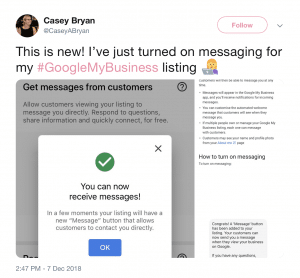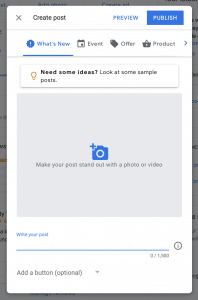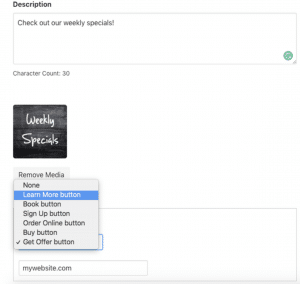You already have a marketing strategy for driving people toward your website. But you’ve probably also heard me say that traditional SEO and website updates are becoming less important than they have been in the past. There is, however, a tool available that will allow you to provide resources in a way that makes Google more likely to send traffic your way: this tool is Google Business Profile.
Google Business Profile is an online listing that your firm can leverage in order to reach the top spots in Google’s organic results, when people are searching for legal help in your geographic area.
Companies like Google, Facebook, and others want to keep users inside their walled gardens, instead of watching us (and the money we represent) click through to external websites. You, as a business owner, may be accustomed to providing many features and types of information on your website, but Google is now building tools that will allow you to provide that content from inside their own search results.
In this guide to local SEO for lawyers, we’ll teach you how to set up a Google Business Profile listing for your law firm, how to maintain it, and how to maximize results with unique tips you might not have heard before.
Why is Google Business Profile important?
Before we dive into the details, let’s be clear on exactly what a Google Business Profile listing is.
Put simply: a Google Business Profile listing (GMB listing for short) is a branch of local SEO that targets people in your firm’s local area through organic search.
The most notable benefit is that law firms with a well-optimized GMB listing show up in the “three-pack” at the top of your target client’s search engine results page (SERP).
Here’s an example for “lawyers in Philadelphia:”
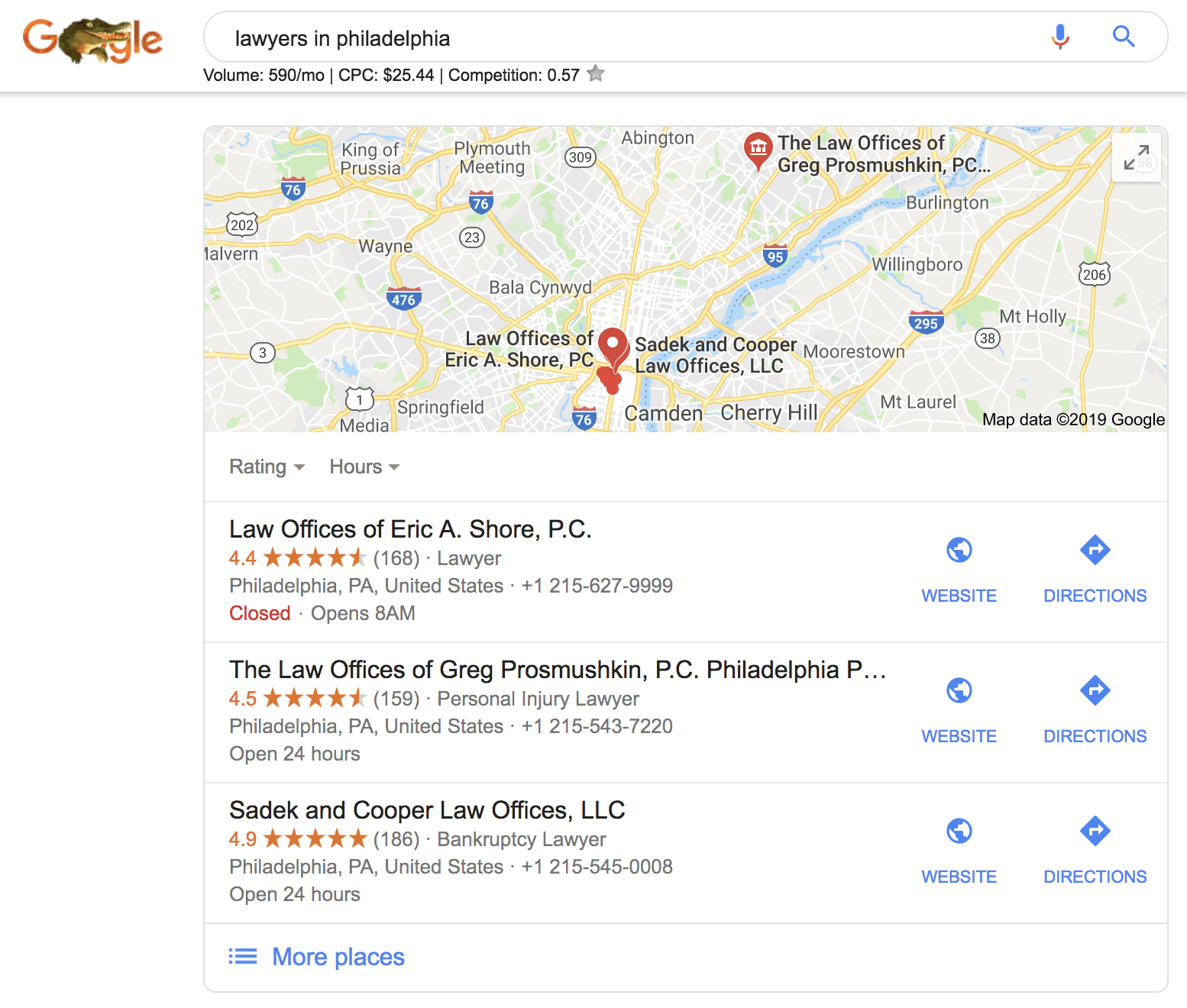
Notice how the three-pack is the first thing I see when my results page loads?
By positioning your firm here, you’re maximizing the likelihood of a target client finding you through organic search, rather than hoping they’ll scroll past the three-pack (or paid results) to find your website on their own accord.
Plus, almost a third of mobile searches are related to a location, and 86% of consumers rely on the internet to find a local business.
Your potential clients are actively using Google to find you.
Data added to a Google Business Profile listing is also shown when using Map search:
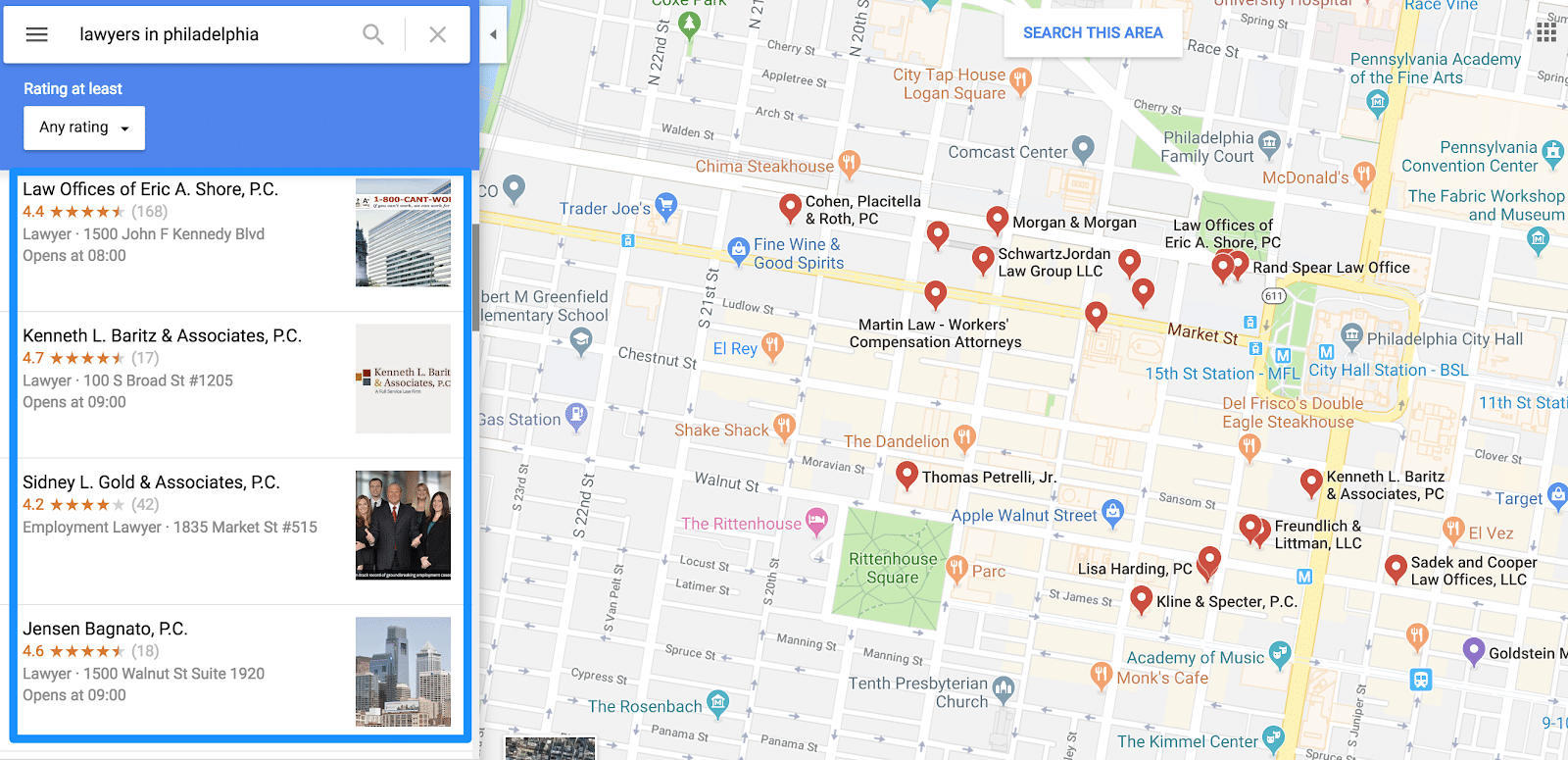
But here’s the best part about creating a Google Business Profile listing for your law firm: 50% of consumers who conducted a local search on their smartphone visited a store within a day. It’s highly likely that potential clients searching for a law firm call the firms they discover with even more frequency. After all, a legal problem is like an aching tooth: it requires prompt attention.
That means if you’re able to gain more Google real estate in your client’s search results, there’s a big chance they will click through to your website, or book a consultation with your lawyers in the near future.
It’s even more important for lawyers and attorneys
Google Business Profile listings are a fantastic way to drive more clients toward your practice, especially those all-important ones who are searching specifically for the services you offer.
In fact, it’s especially useful for attorneys, because your target client may be someone who’s going through a personal matter, such as a divorce, a financial issue, or another potentially embarrassing concern.
Lawyers in practice areas like bankruptcy, criminal defense, and divorce often find that clients won’t follow them on social media because activity can be public.
They’ll head to Google and complete a private local search, instead.
By creating a Google Business Profile listing for your firm, you place yourself at the forefront of the searcher’s mind, without having to encourage them to publicly “like” your Facebook Page.
[ While I have you here, I wanted to remind you that you can get the latest articles delivered to your inbox a week before they go up on the web. Just one email per week. Sign up here. ]
Google Business Profile vs. owned media channels
If you’re relying on press releases, blogging or other types of content published on a website, those outlets are likely becoming less effective than they were in years past.
That’s because Google has started funneling traffic away from websites. Its algorithm has begun displaying information (taken from a variety of sources) directly in the SERPs, so searchers don’t need to click on a third-party website.
Just take a look at my results page for the phrase “how to get a divorce:”
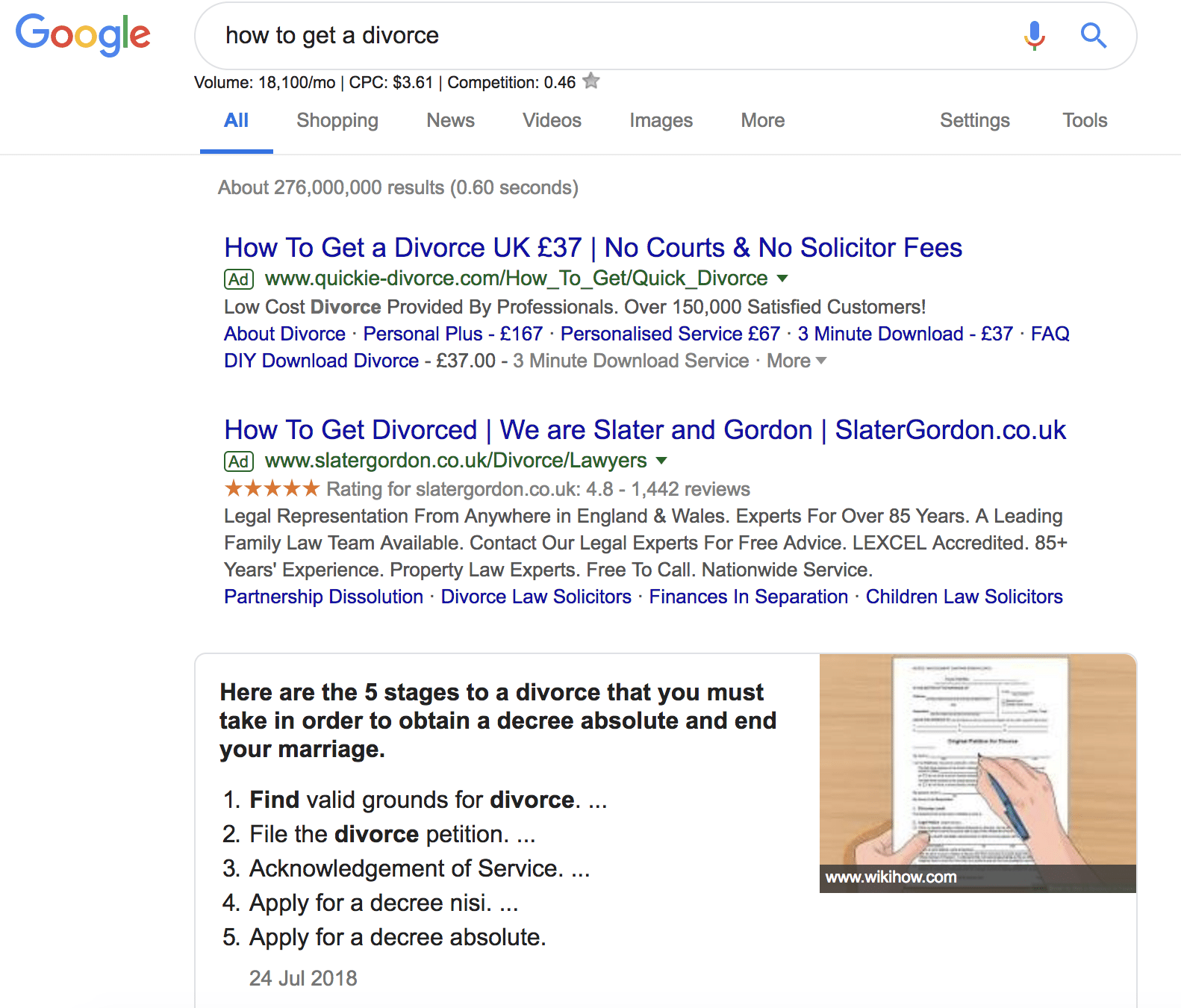
Nestled just below the promoted results is Google’s featured snippet box, which displays advice from a top-ranking website without the searcher having to click the link.
Here’s the bottom line:
If you’re relying on website content to attract potential clients through Google, you’ll need to come to grips with the fact most people won’t click any results at all–and you need to find another way to attract their attention in a crowded results page.
Maybe that’s why Google offers its own website hosting service: to have more control over the content they’re promoting in SERPs. This is a great option if your law firm doesn’t already have a website, but if you do, don’t create another. That could cause duplicate content issues, and cause your original site to perform even worse.
Luckily, Google Business Profile listings can help you achieve the visiblity you need.
These directory-style listings don’t require people to leave the Google platform in order to view information about your law firm. This encourages Google’s algorithm to show you in search results–whether that’s in the three-pack or Map searches.
The best part? You have control of the information you’re adding to your law firm’s Google Business Profile listing, instead of allowing Google’s algorithm to take random snippets from your website to display to searchers.
That’s bound to lead to more search traffic, awareness, and potential clients than a traditional piece of content posted to your website would.
How to set-up your law firm’s Google Business Profile listing
Ready to create your firm’s Google Business Profile listing, and reap the rewards that come from creating Google-owned content?
Head over to the Google Business Profile homepage and press Start Now.
You’ll be taken to another page that will prompt you to enter key details about your business, including:
- Business name
- Location
- Contact number
- Email address
- Website
- Category (or industry)
Selecting a category can often be tricky, since you likely offer several legal services. However, Kristal Terrell, Marketing Assistant for Get Online NOLA, recommends:
“Selecting a primary business category and additional business categories is really useful. Categories describe what your business is such as “Lawyer” “Law Firm” “Civil Law Attorney” “Tax Attorney” “Family Law Attorney” Etc.”

[ I'm glad you're enjoying the Friday File. I share my best marketing and practice management advice exclusively with my email subscribers every Friday. Join now. ]
Once you’ve gone through this process, you’ll need to verify your Google Business Profile listing. There are various ways to do this; the easiest way is to allow Google to send a letter to your physical address.
Head over to the Google Business Profile homepage again, and click the Start Now button.
On the next page, type the name of your firm. This should be displayed as a business in their database, since you’ve already entered details about your business.
Here’s an example:
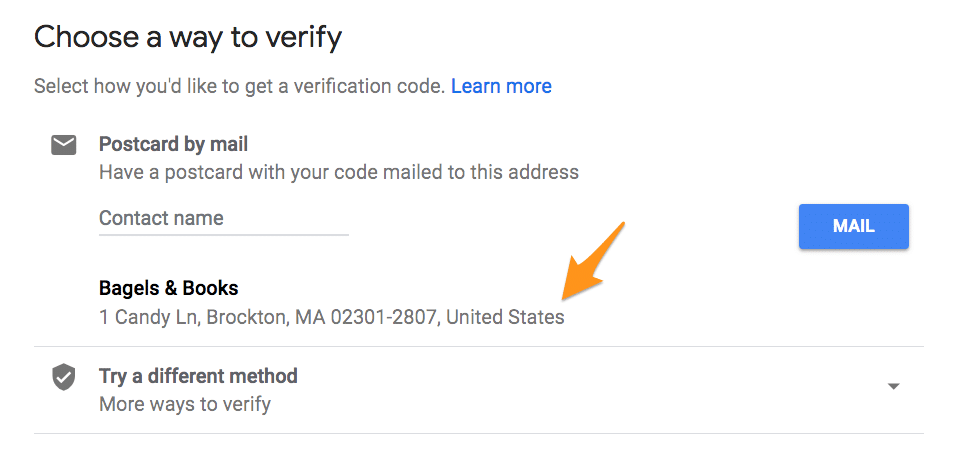
Then, double-check that the information displayed is correct, and hit the Mail button.
Google will then send a unique verification code to your physical address. You’ll need to add the code to your account:
- Sign into your Google Business Profile account.
- Select the location you want to verify.
- Click Verify location.
- Enter the five-digit code you received in the mail, and press Submit.
Bingo!
Google will now activate your listing, and make it visible to people who’re using their search feature to find local businesses.
4 key features to monitor when you go live
Now that you’re up and running with your Google Business Profile listing, you might fall into the trap of letting it “do its own thing.” But remember: people won’t always click through to your website, fill out your contact form, or dial your phone number.
Chances are, some prospective clients will interact directly with the listing, rather than going to your website.
So, how can you find these people, and convince them to schedule a consultation with your team of attorneys?
You’ll need to keep a close eye on these four features, and check in regularly to confirm that you’re not neglecting warm leads:
1. Messages
Google has started rolling out a messaging feature, which allows people viewing your listing to message you directly. These messages don’t come through email or SMS; they arrive through the messaging feature in your GMB account.
Enable this feature by:
- Downloading the Google Business Profile app through the App Store or Google Play.
- Selecting the platform you want to allow messages on.
- Selecting Customers.
- Selecting Messages, then Turn On.
The text messages sent by your audience are routed through a cell phone number owned by Google, and the only way to respond is through your GMB account..
You should receive an SMS message notification whenever a visitor leaves a message, but you can sign into your Google Business Profile account, head back to the Customers page and select Messages to view them all.
People will likely use this messaging feature as a way to ask questions about your business.
[ Ready to put these ideas into practice? I have a 10 day email course called Rosen's Rules that will help you take action starting right now. It's completely free, and this time in 2 weeks, you'll be a lot closer to having the practice you deserve. Sign up here. ]
But you’ll need to follow Google’s guidelines for communicating with customers through this feature, which include:
- Not asking for sensitive information, such as passwords or credit card details.
- Not sending irrelevant or unwanted messages to customers who have contacted you.
- Not sending inappropriate content, such as harassing or discriminating messages.
- Not sending unsolicited messages or unwanted business-related content.
- Avoiding slow or unreasonable response times to messages, or no response at all.
(I know those guidelines sound like common sense, but they’re a useful reminder of how to interact appropriately online.)
2. Bookings
If you’ve done an awesome job of creating your Google Business Profile listing, you’ll start to see a stream of new clients filtering through–that’s fantastic!
But remember: you want to make it easy for people to book an appointment with your legal team.
To do this, you can use the Bookings feature offered by Google in your firm’s listing.
To enable this:
- Select the location you want to enable in your Google Business Profile account.
- Press Bookings.
- Select a partner from the drop-down menu, such as SquareUp, Appointy or TimeTrade (full list here). You can also choose to sync these bookings with your Google Calendar.
- Start receiving bookings through your listing; they’ll automatically be created and scheduled through the partner platform you chose.
Let’s put that into practice and say you’re encouraging clients to book a free consultation with your team of lawyers. Using the Bookings feature in your listing and the SquareUp integration, clients are given a list of appointment times. All they need to do is click the time that suits them, confirm their appointment, and they’re booked.
You’ll receive a notification that the booking has been made. And if you’ve synced your Google Calendar with your listing, the appointment will appear on your team’s calendar.
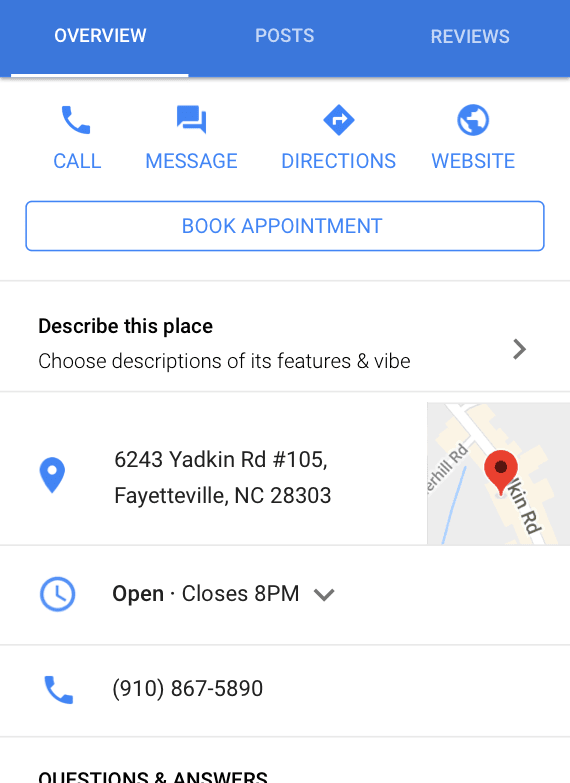
3. Reviews
Did you know that Google is now the biggest review website, beating traditional sites like Yelp, TripAdvisor and Facebook?
It’s true: 6 out of 10 people look to Google Business Profile listings for company reviews:

People are able to leave public reviews of your law firm on your Google Business Profile listing. And although it’s not officially confirmed that these reviews positively impact your chances of ranking in the local three-packs, it’s safe to assume it’s an advantage.
Google wants to show the best results for a local search query. They’re more likely to rank a highly-rated law firm than one with several 1* reviews (or worse, none at all).
Here’s what that looks like in practice:

To find the reviews left on your law firm’s Google Business Profile listing, sign into your account and press the Reviews tab.
Here, you’ll find a list of reviews left by previous clients, with the option to respond:

It goes without saying that you’ll want to collect as many glowing reviews as you can, within the bounds of the ethics rules. Not only can it help boost your law firm’s local SEO strategy, but it’s impressive to potential clients who view your listing.
4. Insights
Do you know how many people have seen your Google Business Profile listing? How did they find you? Are they clicking through to your firm’s website?
All three questions (plus many more!) can be answered in the Insights tab.
Head over to your Performance dashboard; you’ll find analytics on how well your GMB listing is performing:
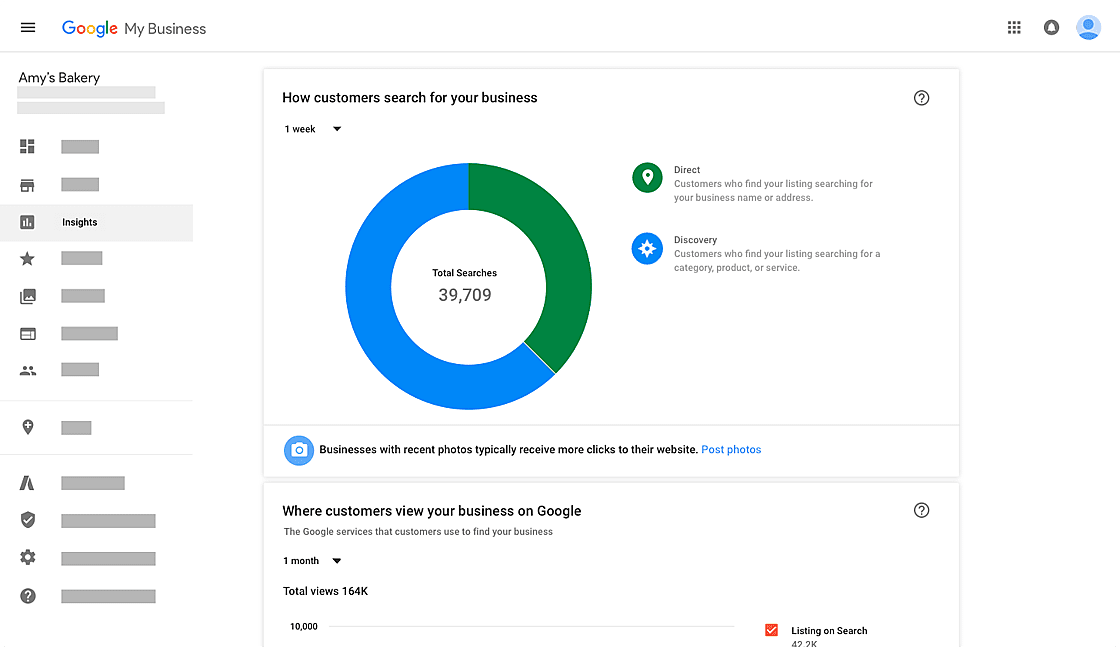
The most important metrics to check include:
- Actions: How many people clicked through to your website, requested directions, or made a phone call as a result of your GMB listing?
- Search data: How many customers found your listing through searching your brand name, versus a product or service you offer?
- Photo data: Are people clicking on your photos? Which are most popular?
- Viewing data: Did people visit your website through a text or Map search?
Regardless of what you’re focusing on, there’s no doubt that the dashboard is a goldmine, especially if you use the data to tweak and re-optimize, in order to attract more visitors.
(More on that later.)
How to stay up-to-date with your listing
A Google Business Profile listing is a machine with several moving parts.
There are four main things to check, but if your listing takes off and you’re overflowing with more messages than you know how to handle, here’s how you can stay up-to-date with the features we’ve mentioned:
- Assign a single team member to “own” each feature. For example: your customer service manager can handle reviews, whereas your intake manager can handle appointments.
- Encourage the people who “own” each feature to create a daily or weekly schedule, depending on the volume of things they’re responding to. This could be a Friday morning, or every afternoon before they finish work.
- Use add-on tools to make your listing easier to manage, such as Moz Local (if you’re managing several locations) or the Agency Dashboard (if you’re working with an external marketing agency, but still want oversight of your firm’s listing).
- Consider outsourcing the day-to-day management of your listing. For example: can you hire a virtual assistant to respond to messages? Can you hire a contractor to respond to the reviews left on your listing?
How do you optimize your law firm’s GMB listing?
You’ve entered the details of your law firm, activated your Google Business Profile listing, and are starting to see a small stream of inquiries.
However, it’s not time to relax just yet.
There are likely hundreds of other law firms competing with you for clients, so it’s not easy to appear in the three-pack for a local search like “lawyers in Michigan” by just entering your business information.
In order to transform your Google Business Profile listing into an inquiry-generating machine, you’ll need to optimize it, using the many factors Google’s algorithm takes into consideration when displaying results pages for local searchers:
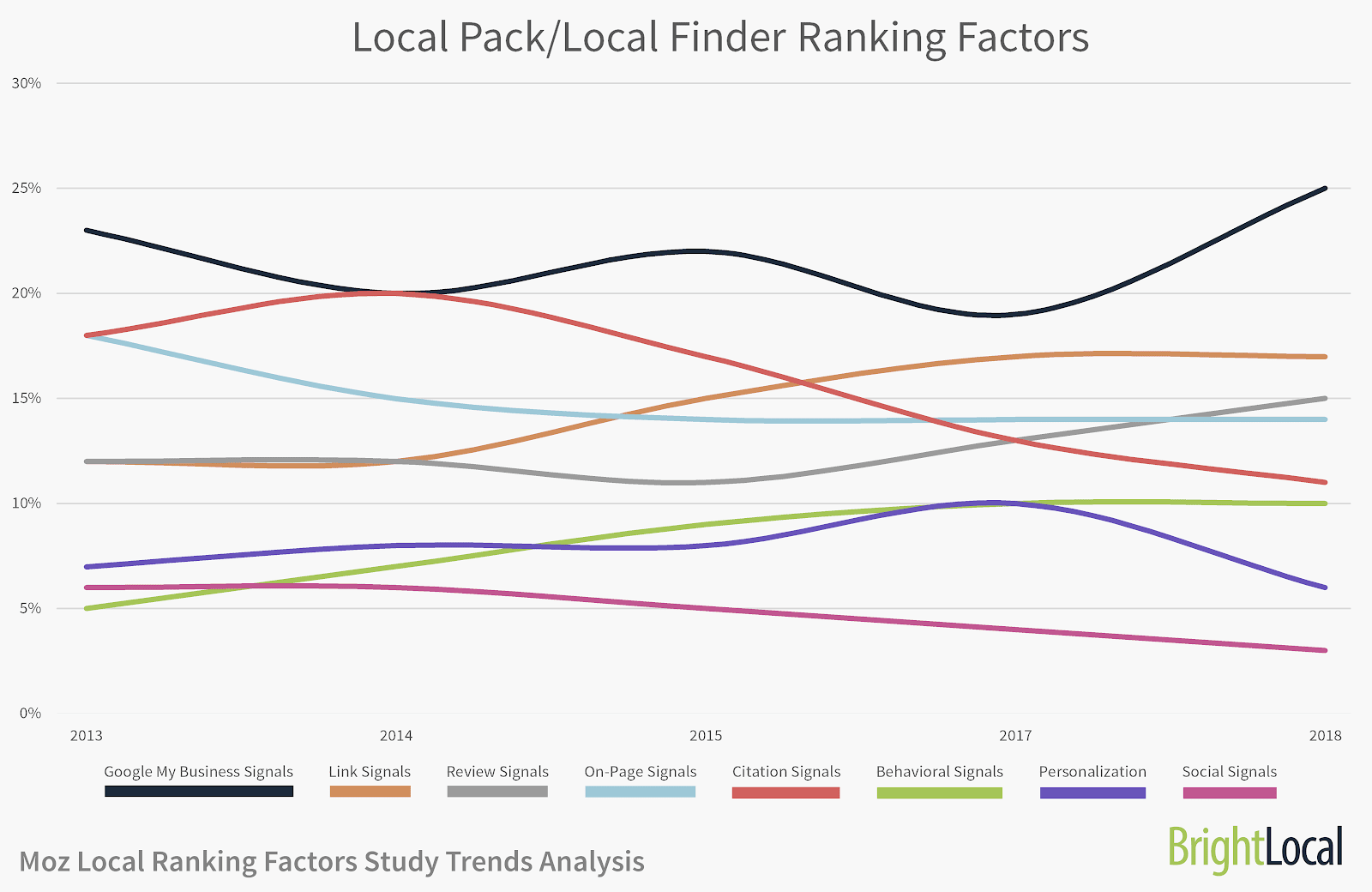
If that sounds confusing, or you’re feeling overwhelmed, don’t panic.
Here are eight tips you can use to optimize your law firm’s listing, and reach the coveted three-pack in local search.
1. Include as much information as possible
Google’s aim has always been (and will always be) to show the best, most accurate results for anyone’s search query. If they didn’t, and their search results pages gained a reputation for being useless, nobody would use their platform.
That’s why it’s important for your law firm’s Google Business Profile listing to include as much information as possible, such as:
- Business hours
-
- Address
-
- Contact details
-
- Photos and videos
-
- Service area
-
- Opening date
Empty fields, inaccurate opening times, or a lack of information about what your business does won’t fit Google’s “highest-quality” guidelines. As a result, you’ll have a tough time trying to get into the three-pack for your local audience.
Think about it: Google is more likely to feature a firm in the three-pack if their information is complete–much more so than one with incorrect (or missing) details, right?
That’s likely why Kingsley Napley LLC ranks in position #1 of the three-pack for “law firm in London:”
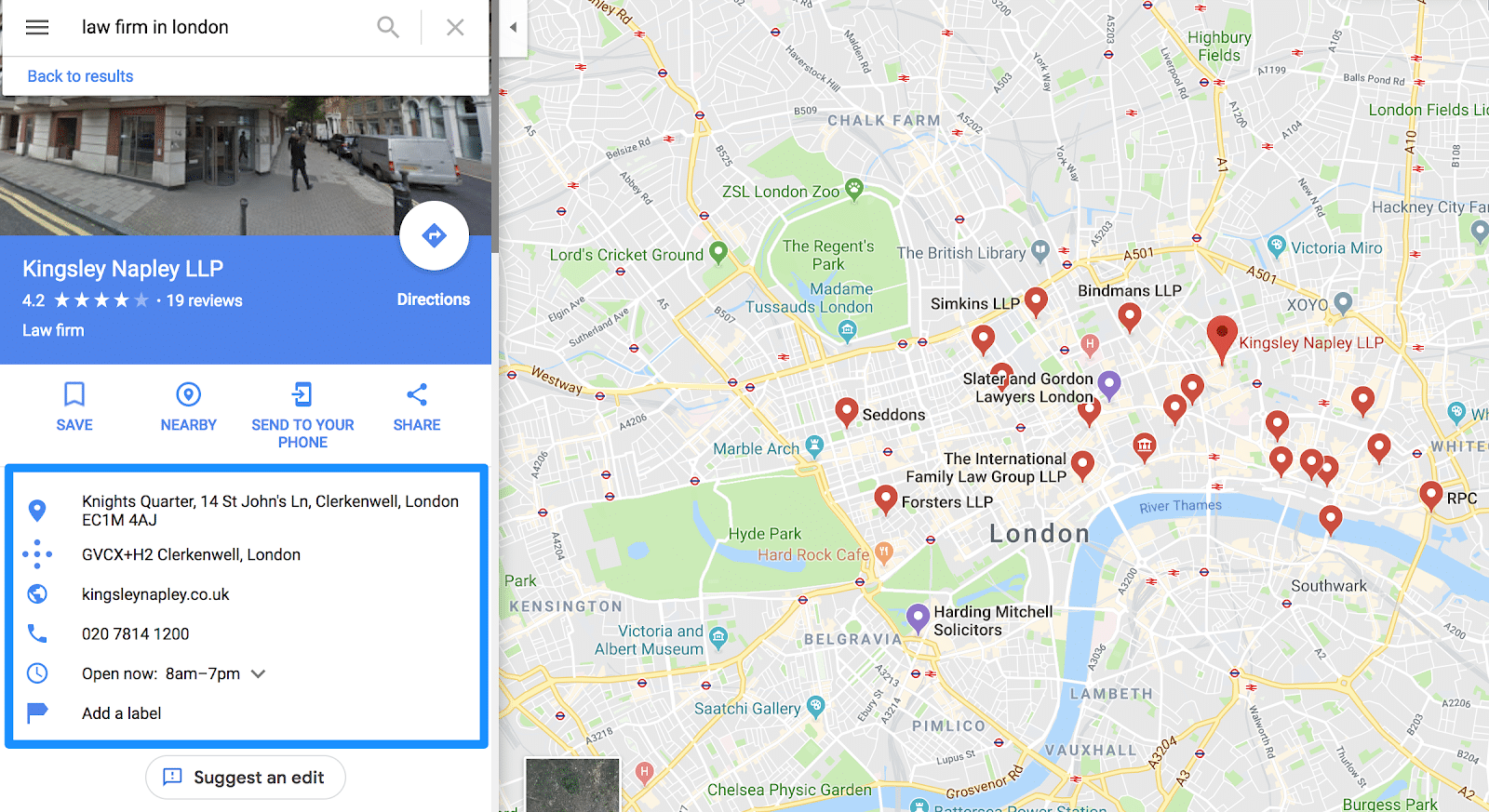
You might be thinking this step isn’t necessary if you’ve already taken the time to make sure your phone number, address and opening hours are accurate throughout the creation of your listing.
But don’t fall into the trap of only checking the information on your listing when you’re creating it.
You should regularly check back over your listing every month or so, and update the information if it’s no longer accurate. That’s likely to happen when:
- You’ve changed contact numbers
- You’ve moved offices
- You change your website from HTTP to HTTPS (business listings with a website get 25-35% more clicks, so this one is critical)
- You have an old Google Business Profile listing and you’re now starting again from scratch
Finally, check the information against any other directory listings you’ve built. Google’s algorithm may check this, because NAP consistency (Name, Address, Phone Number) is the ideal way to check whether business information is accurate. Given how many directory listings you may have already, it makes sense to use a service such as Moz Local to automate NAP consistency monitoring.
This is even more important since Google recently started to crack-down on inaccurate Google Business Profile listings. A recent announcement said:
“Hey everyone,
We’d like to let you know about a new way to report fraudulent activity relating to businesses Google Maps.
If you come across a business name, phone number, or URL on Google Maps that leads to fraudulent activity, you can now submit a complaint using this form.
We’ll close the Spam board on this community, so please use the new form to report spam-related issues. Complaints submitted through this form will be reviewed in accordance with our guidelines for representing businesses on Google Maps.”
Spammy or factually incorrect listings, along with those with tons of fake reviews, are now being removed from the platform. They’re even encouraging the general public to report incorrect listings through a Business Redressal Form.
In a nutshell: If you’re littering your listing with inaccurate information, you could be at risk of your hard work going to waste.
(That’s not what we’re aiming for.)
2. Including photos
When you’re creating your law firm’s Google Business Profile listing, you’ll have an option to upload photos and videos that are visible to people who click your result for more information.
Why not visually show them you’re worth their time when making an inquiry?
Photos show that your business is “real,” and that you’re a personable firm potential clients can make a connection with. It’s no surprise that one report found 60% of consumers said local search results with good images captured their attention and pushed them toward a decision.
That’s perfect for a Google Business Profile listing, where you’re actively competing with several other law firms for the attention of your potential clients.
Just take this example from Schwartzapfel Lawyers’ NYC listing:

Notice how the photos of their location and team make them look like a “real business?”
That’s likely why they’ve landed themselves in the three-pack: because they’re providing their audience with tons of information, and they look like a reputable (and trustworthy) business. You could do the same, and attract more clients through your firm’s Google Business Profile listing, by uploading photos.
Jon Rodriguez, a Senior Digital Strategist for Red Olive, explains the types of photos you should include for maximum engagement:
“With my clients, I have seen adding a 360 office tour of an office increase organic traffic by 5% to 10%, not to mention profile engagement.
For photos, Exterior and Interior images are a must. Additionally, include any signage linking the law firm to its location. This can include your listing on the business directory sign, monument signs, canopy signs, marquee signage, or any other signage visible to someone driving by the business.”
(Not all photographers offer 360-photos, so you might have to do a personalized, specific Google search to find one–such as “360 photography London.”)
Maximize the advantage of including great photos in your listing. Google provides specific photo recommendations:
- Format: JPG or PNG
- Size: Between 10 KB and 5 MB
- Minimum resolution: 720 px tall, 720 px wide
(Read Google’s full guidelines for uploading images.)
Devin Beverage, SEO Expert and Founder of DevBev Co, also recommends naming your images before uploading them to your listing for maximum optimization:
“Regularly uploading photos boosts your Google Business Profile rankings. Double up the benefits by naming your images strategically before upload. This can lead to them appearing in Google Image search results, which can still potentially get you noticed.
“Consider as an example: for a divorce attorney in Houston — “divorce-attorney-houston-brian-walters” would be your file name.”
But if you’re still not convinced about using images in your listing, here’s the best part: Photos are yours; your competitors will have a tough time copying them.
Talk about a competitive advantage!
3. Respond to public customer questions
Remember how earlier, we briefly talked about the messaging feature your Google Business Profile listing comes with?
Although some people may use the private message feature to ask questions about your law firm, some local searchers might ask questions publicly using the “questions and answers” feature.
Take a look at these questions answered by Allred, Maroko & Goldberg on their Google Business Profile listing:

A report by Get Five Stars (now GatherUp) found 25% of locations on Google Maps have questions. If one is left on your Google Business Profile listing, you’ll receive an email like this:
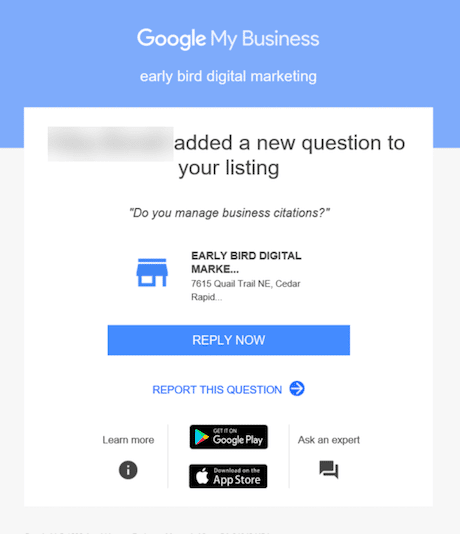
It’s important to answer these questions.
Why? Because the people leaving questions on your profile are genuinely interested in your legal services, and could be ready to hire your legal team if their question is answered.
Think of them like a “hot lead” that you want to convert as soon as possible.
Plus, other people might be asking the same questions in their mind, but be too afraid (or not yet ready) to reach out. By making the answers to those questions public, you might be guiding them through the customer journey much faster.
You should also answer every single question left on your firm’s Google Business Profile listing because they’re open for anyone to answer–including your competitor.
Granted, it might be rare for a competitor to poach your clients by answering questions left on your listing. But, it’s a possible opportunity for them that can be prevented by leaving a response yourself.
This could give you an advantage that will bump you up into the three-pack, because you’re making content accessible through Google’s own platform (rather than your website). Google rewards businesses who keep users on a Google-owned site, rather than a third-party one.
4. Post content to the Google Posts platform
You might’ve heard the conversation around Google+ being made redundant and assumed you can’t create content on the Google platform anymore. That’s incorrect; you can connect your law firm’s Google Business Profile account to Google Posts.
Use this to your advantage and create Google-owned content to go alongside your listing.
(Remember: Google wants to keep users on their platform rather than redirecting them to a website–and they’ll reward you for it, potentially with the three-pack result.)
Once you’ve connected the two accounts, content published to the Posts platform will be accessible through your GMB listing.
First time I’m seeing snippets from Google Posts being pulled into the local finder.
Y’all seen this before? @mblumenthal @JoyanneHawkins @ndyjsimpson pic.twitter.com/yIwKCEfOKj
— Dave DiGregorio (@deegs20) February 8, 2019
“What exactly is a Google Post?” I hear you asking.
It’s similar to a social media update, like a tweet or Facebook update. There are three main types of Google Post that you can choose from when creating content for the Google Posts platform:
a) What’s New posts
This style of Google Post is likely to be your most-used. It’s typically used to provide general information about your business.
But what should you post about?
Digital Marketing Manager Jeff Moriarty explains:
“One recommendation I always give to my law firm clients is to post about your different cases if you can. These posts can be about cases you have won or cases you are currently taking on and they can be a broad description of them, they don’t need to be specific.
This not only shows more trust in your company, it shows off your successes, and helps to tell Google that you are proactive with your GMB listing.
It’s free to do and most companies don’t even know this option exists.”
What’s New posts have a field for text, a photo/video option, an external link, and a call-to-action button. You don’t have to use all four, but it’s the perfect option for posting content regularly and engaging local searchers.
b) Event posts
Are you running a special event? Perhaps you’re supporting or sponsoring a local meet-up, or hosting an online webinar. Either option can make for fantastic Google Business Profile content, because the details are accessible through your business listing:
https://www.youtube.com/watch?v=oRz2DrFLuUg
To publish this type of post, you’ll need to include key details about your event. That includes:
- The start and end date
- The event title
- A description (a great way to target local keywords)
- A call to action
- Optional: Photos and videos
Let’s put this into practice and say your law firm is running a free webinar on the process for a divorce. By creating an Event post, you’ll be raising awareness and encouraging people to tune in when they visit your listing–all through one single post.
(Event-style posts stay live until the event date. When this time passes, the Post will be automatically removed–meaning you’ll have to create the post again, should you run the event again.)
c) Offer posts
Do you offer discounts on your legal services packages? Do you have document review specials? Do you sometimes offer a free consultation?
Offer posts are a superb way to raise awareness of them, and give local searchers who land on your Google Business Profile an incentive to reach out.
This type of Google Post also requires a start and end date, along with a choice of photos, videos, links, and terms and conditions. However, the call to action is simply a “View Offer” button.
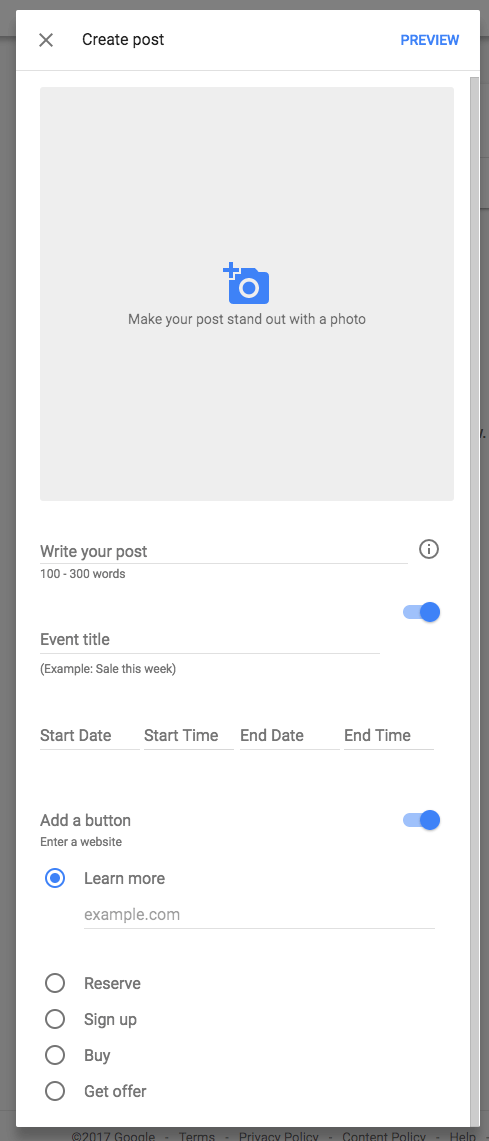
Ready to start publishing content to Google Posts?
You don’t need to set constant reminders to hit the “publish” button; tools like OneUp can schedule Google Posts on your behalf. Simply create your account, connect your GMB listing, and spend a few hours batching the content you’d like to post, scheduling each post to automatically publish at a given time:
Remember to hit your local SEO checklist by including the local keywords in your content. For example: If you’re targeting “law firm in Chicago,” include that phrase, along with 3-5 similar keywords, in your content to prove relevance.
5. Respond to all reviews… even if they’re negative
Having a top-rated Google Business Profile listing is the easiest way to help you reach the three-pack because you’re proving that you’re a trustworthy firm.
Think about it: If you were Google, which of these lawyers or attorneys would you rank higher in local search?
- A law firm with hundreds of 4-5* reviews
- A law firm with one or two 3* reviews
I’ll bet it’s option A, purely because they look more credible and reputable. That’s the type of business Google want to refer to their local searchers.
(They’re essential for driving clients, too: 21% of consumers agreed that Google reviews were one of the most important factors in their search for a local business, ranking them as more influential than price estimates, proximity, and SERP.)
The simplest way to get more Google Business Profile reviews is to create a custom link that directs people to leave a review, and set up an email automation that sends the link automatically when a client’s case is closed.
You can create that custom URL by:
- Searching for your business in Google, and locating your listing
- Pressing the Write Review button
- Copying the link from your browser, and sending it to clients
(Top tip: You could use a tool like Rebrandly or Bit.ly to customize these links.)
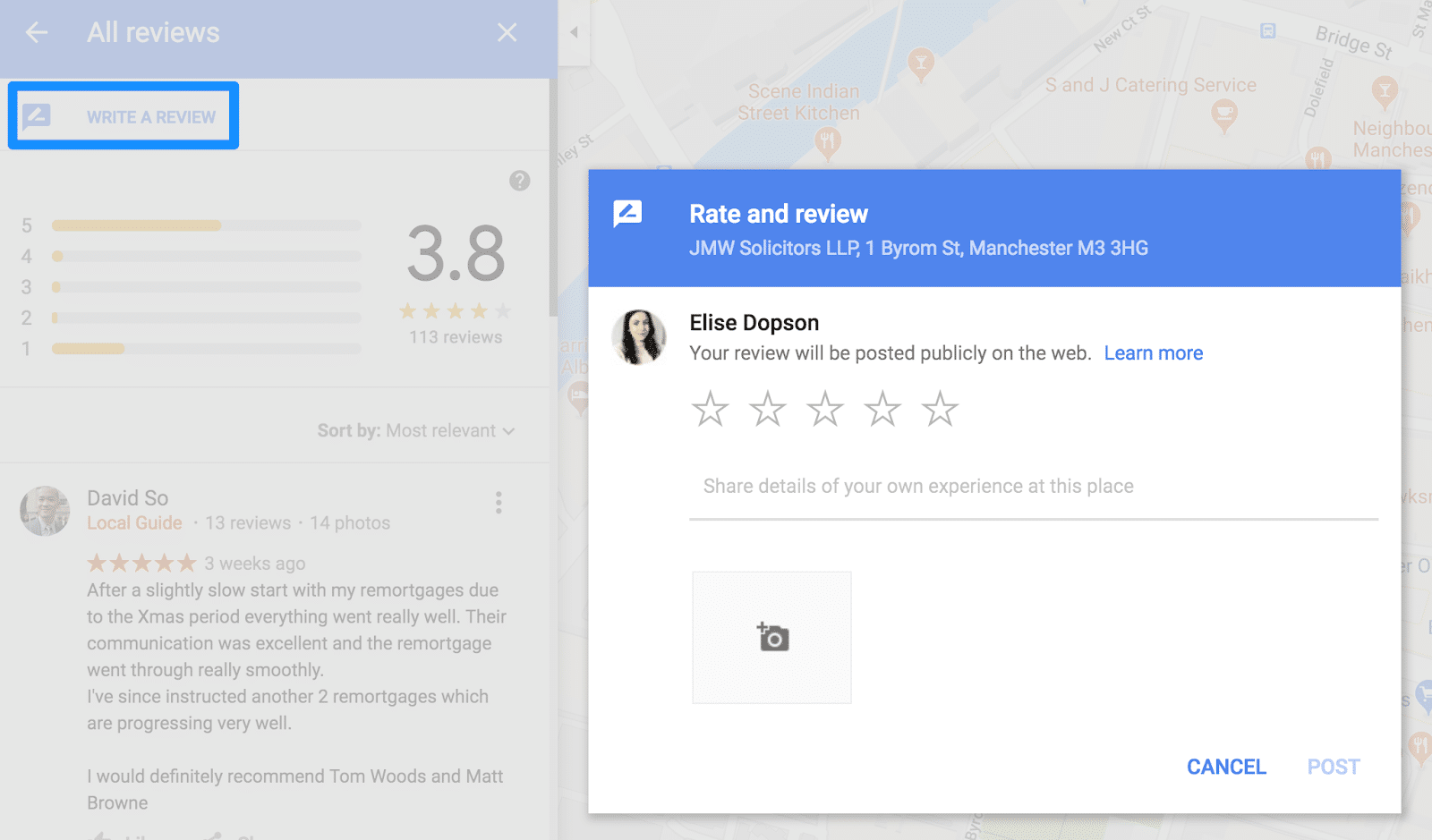
Here’s Matthew Post, co-founder of SEM Dynamics, explaining how you can tailor your approach to boost the chances of clients writing keyword-optimized content for you:
“In any correspondence where you’re asking for a review, be sure to include ideas for the client to discuss. Topics that they can include are the location where services were performed, what type of case was handled, and who helped them are all great suggestions to give clients for writing reviews.
This will help guide people to naturally include keywords into [their] reviews.”
After encouraging former clients to review your law office (keeping in mind any ethical restrictions), you might find that not all of them are as glowing as you’d hoped. Some clients may complain about things that happened outside of your control, but it’s important to respond to every customer review.
That’s not only because 53.3% of customers expect businesses to respond to their online review within 7 days.
Responding to negative reviews on your Google Business Profile listing shows you’re a real human, a personable lawyer. Try to explain the situation and where things went wrong (if possible and if in compliance with applicable confidentiality rules), and reassure them–along with other potential clients reading the review–that you’re committed to making sure the problem doesn’t happen again.
Just take this response by Garratts Solicitors Newton Heath on their Google Business Profile listing, for example:
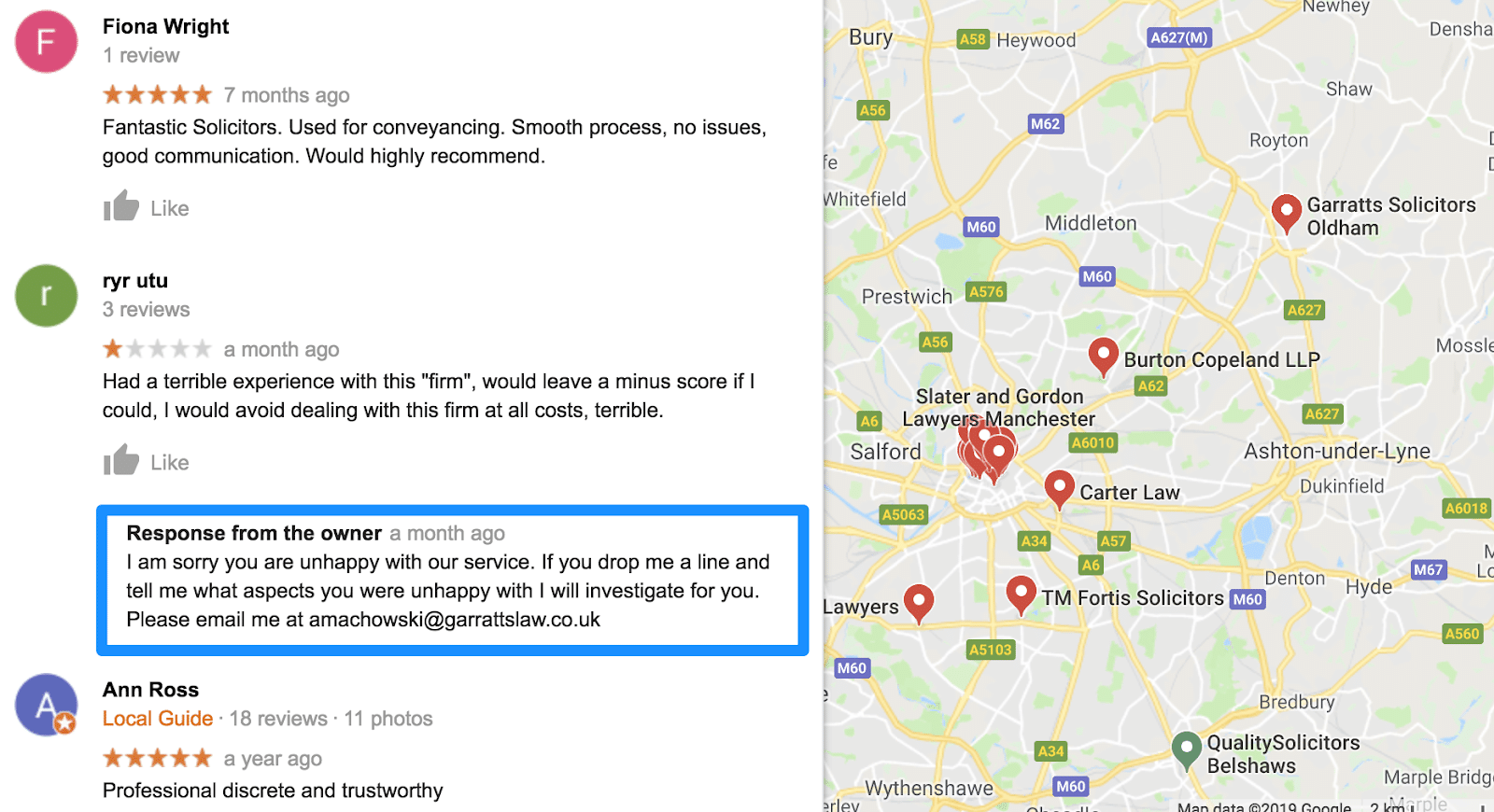
They’ve responded to the unhappy customer within a few days, and expressed their sadness that their firm failed to meet expectations. However, instead of closing with a simple apology, the person responding has left a personal email address so the unhappy reviewer can get in touch. The promise to investigate the problem further demonstrates this firm’s commitment to customer service.
Unsure how to handle a negative review? Google has a full set of guidelines to help you craft the perfect response, but remember that Google guidelines do not supersede the professional responsibility rules in your jurisdiction.
6. Use attributes for your listing
Attributes are statements or words that describe your law firm, shown on your Google Business Profile listing. They can either be:
- Objective: Things you know are accurate, such as “free parking” or “wheelchair access”
- Subjective: Things Google figures out by analyzing customer reviews or feedback, such as “top-rated”
Why not optimize your Google Business Profile listing by adding both types of attributes?
You’re able to add objective attributes, like “free parking,” directly from your GMB account. Simply sign in, select your location, and:
- Click Info
- Find the Attributes section
- Click Edit
- Search for the attribution you’d like to add
- Click Apply
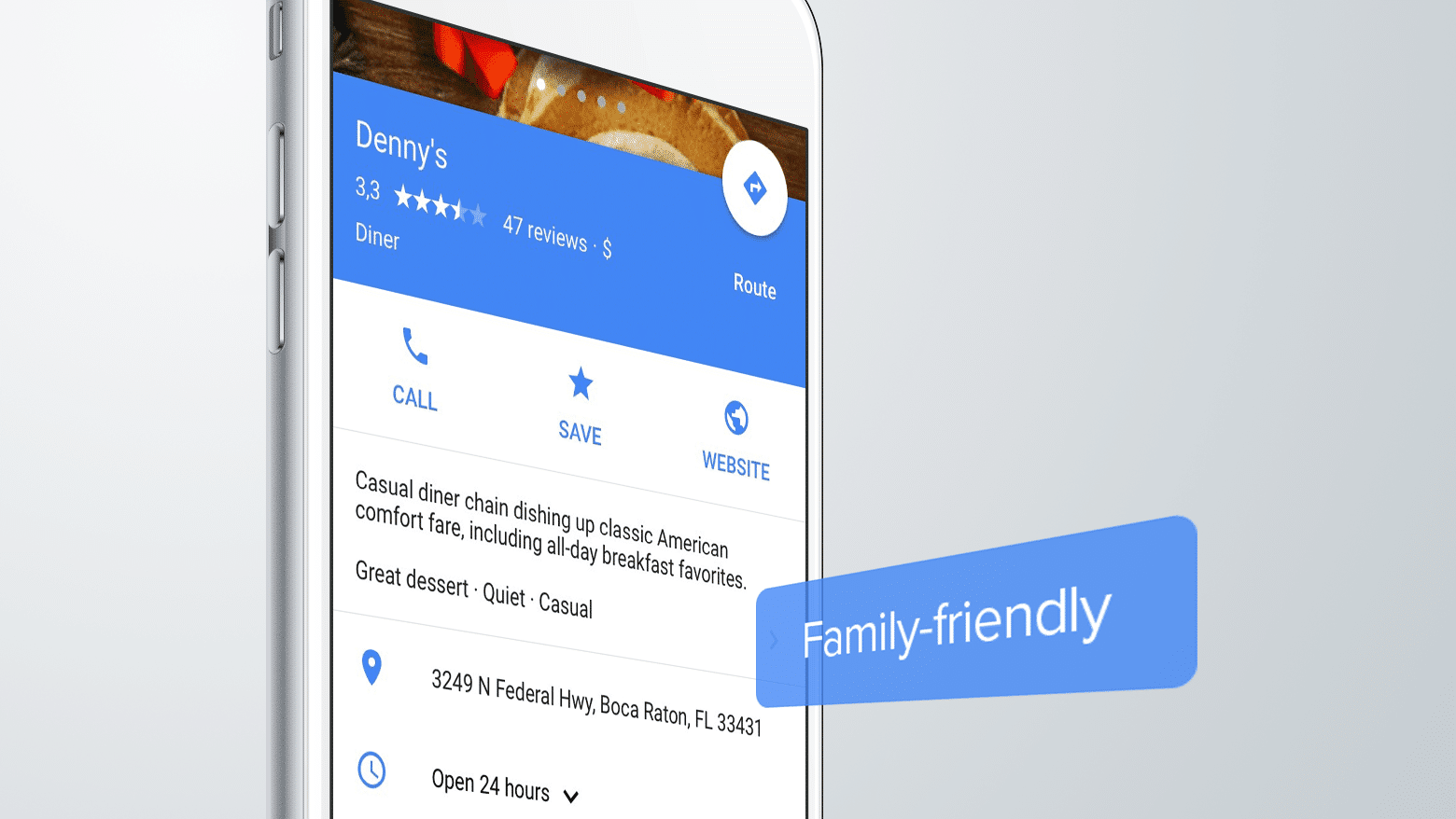
You’re also able to collect objective attributes by encouraging customer reviews on your firm’s listing. Simply ask your clients to answer quick questions about your firm through the link on your listing:
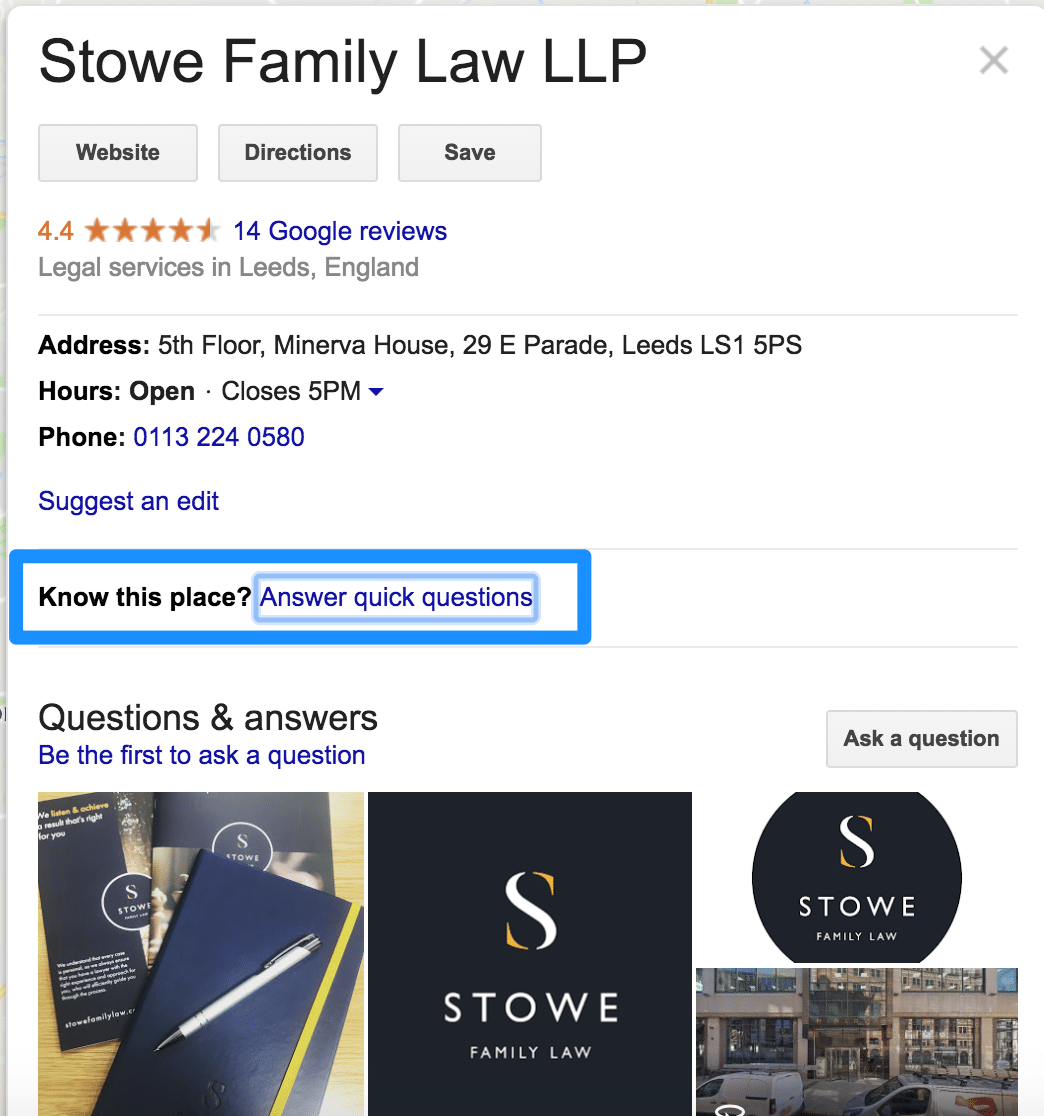
They’ll be asked questions related to the amenities, services, or special qualities your law firm offers:

…and their answers will be used when Google determines your subjective attributes.
7. Test relevant emojis in your content
Emojis have been around for a long time, but you’ve probably only used them in text messages to your friends. You may not realize that you can use emojis in your law firm’s Google Business Profile to target local searchers who use emojis in their search queries.
Surprising, right? Google is one of the first search engines to support emoji search, meaning their algorithm understands what emojis mean, and shows results related to them.
This is happening in local SERPs where you’re fighting to reach the three-pack.
Testing emojis in your Google Business Profile listing could be a fantastic option for law firms, because 92% of consumers use emojis in their online activity.
(It’s an even better local SEO strategy for targeting millennials, 36% of whom prefer GIFs and emojis in order to better communicate their thoughts and feelings, rather than using words.)
Here are the results of my search for “ 👪lawyers in Toronto:”
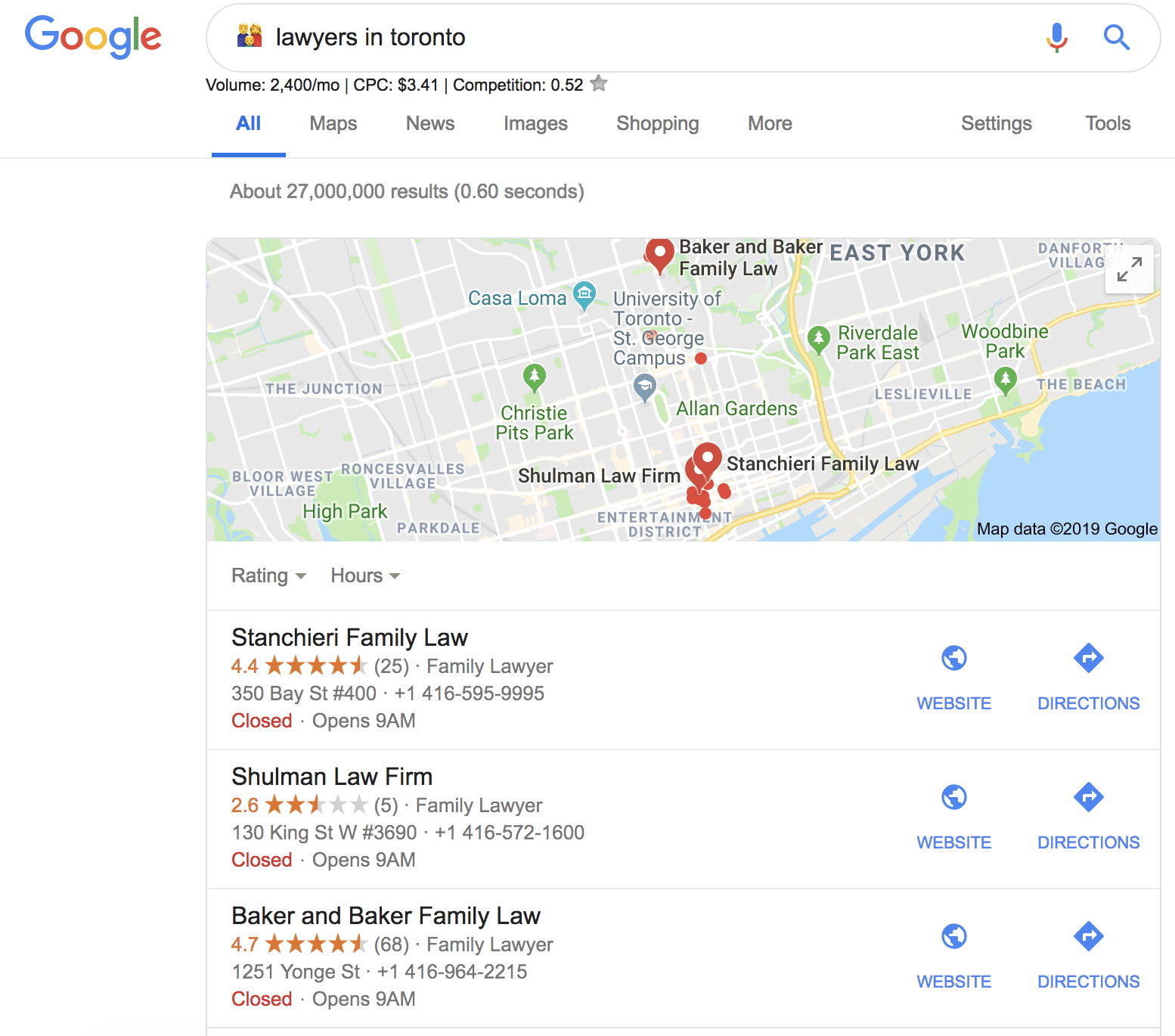
Would you like to reach the three-pack for the growing number of local searchers who are using emojis to find local law firms? The idea that some people use emojis in their search terms may seem ridiculous. Welcome to the brave new world.
Here are some emojis you could use to get started:
- 👪: Family lawyers
- 👰: Marriage-related cases, such as prenuptial agreements or divorce
- ⚖: Justice cases
In your Google Posts, include emojis relevant to the services you offer.
This will help Google to connect the dots between your Google Business Profile listing, and people using emoji search to find law firms near their own location.
8. Optimize calls to action based on Insights
The list of “best practices” for optimizing a Google Business Profile listing can change dramatically from location to location. What works for some firms might not work for others for many reasons:
- Searchers in one location have different search preferences
- Some law firms offer different services
- Different customer journeys have different search requirements
That’s why it’s not easy to use a one-size-fits-all approach to optimizing your listing.
Your Insights tab, however, is a pot of gold. You’re able to see which actions your prospective clients are completing, and make changes based on those actions, rather than taking a generalized approach.
For example: if you find a large percentage of actions are based around a phone call, you know your prospective clients are more likely to pick up the phone than email you. So, add your phone number everywhere (including your Google Business Profile description, photos you upload, and Posts you publish) to encourage more searchers to call you and inquire.
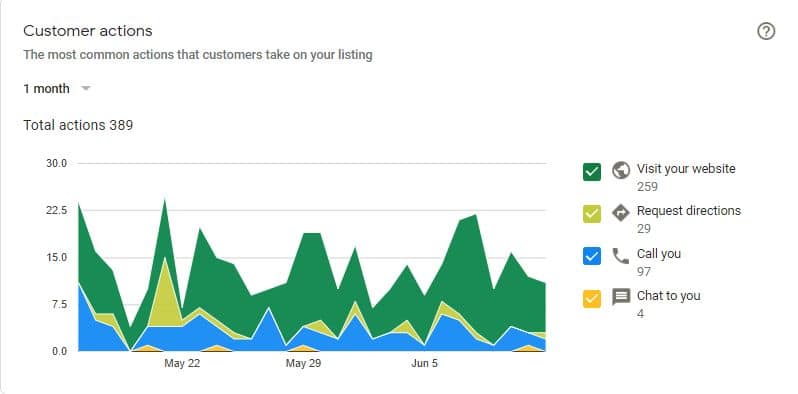
5 awesome resources for keeping up with GMB
Google is always changing. Whether they’re updating their algorithm or changing the way they rank businesses in local search, it can be difficult for business owners to stay up-to-date. That doesn’t mean it’s impossible.
We’ll be updating this article for new features every time they’re released.
But if you’re eager to learn more about local SEO for lawyers and attorneys, you’ll find the following Google Business Profile resources useful:
Final thoughts on using Google Business Profile for lawyers
As you can see, Google Business Profile listings are a fantastic feature that will help your law firm attract more clients through local search. Not only will you stand out on a crowded search engine results page, but you’ll have a great shot at convincing your dream clients to make an inquiry or book a consultation, since your business is more visible in their SERPs.
Remember to always check on your firm’s Google Business Profile listing to monitor Insights and respond to messages, and constantly optimize your listing to make sure you remain in the three-pack.
It’s a tough and constant job, but one that’s worth its weight in gold.
Google Business Profile, when used optimally, works. You’ll increase your visibility, generate more calls from potential clients, increase your revenues, and ultimately put more profit in the bank account.


